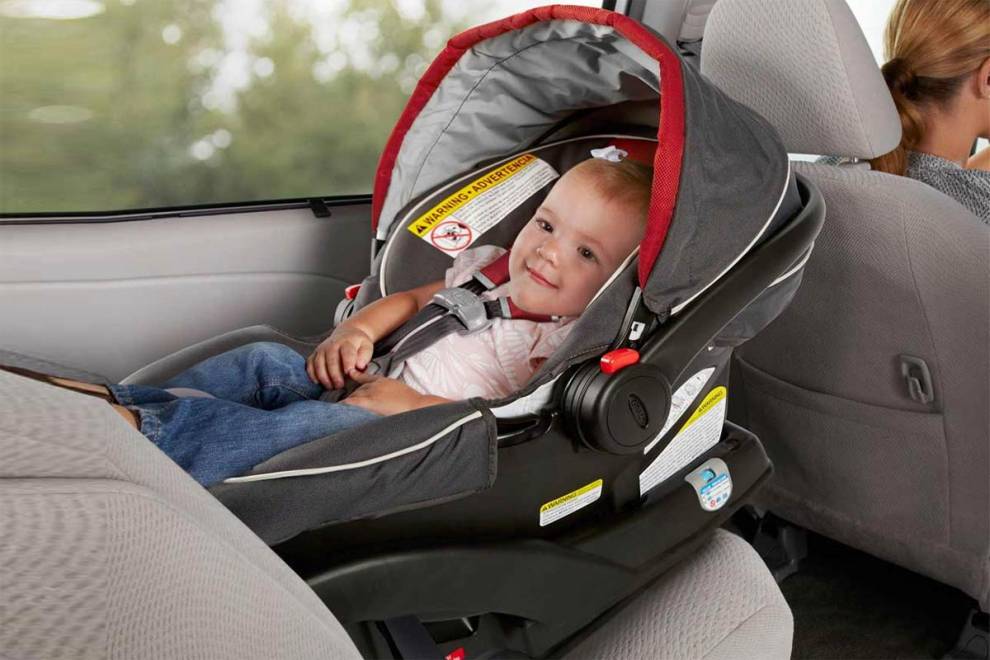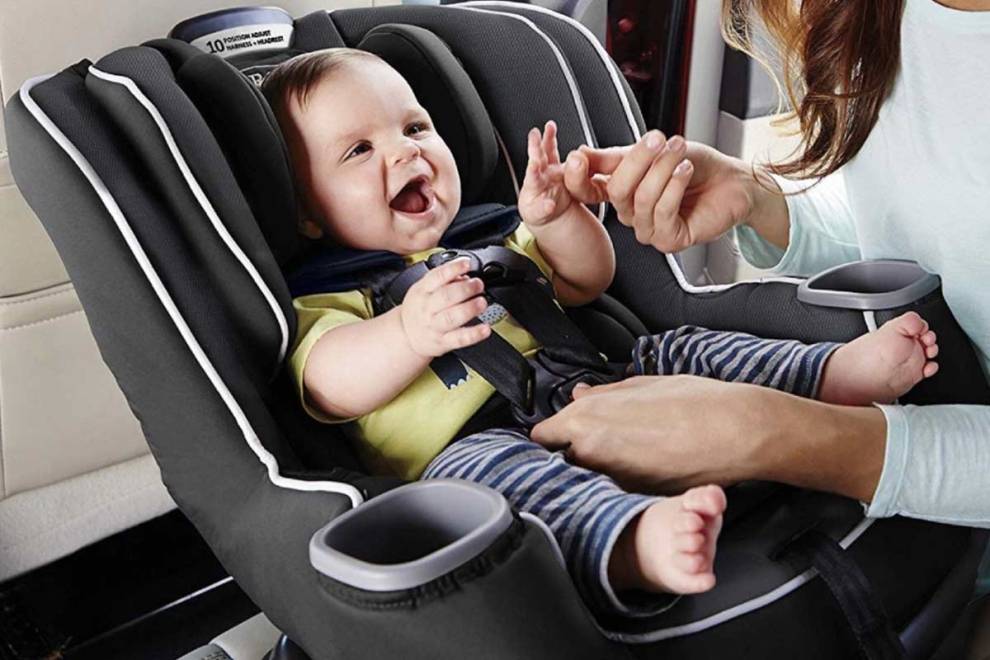These car seats help you fit three in a row while maintaining comfort & safety.
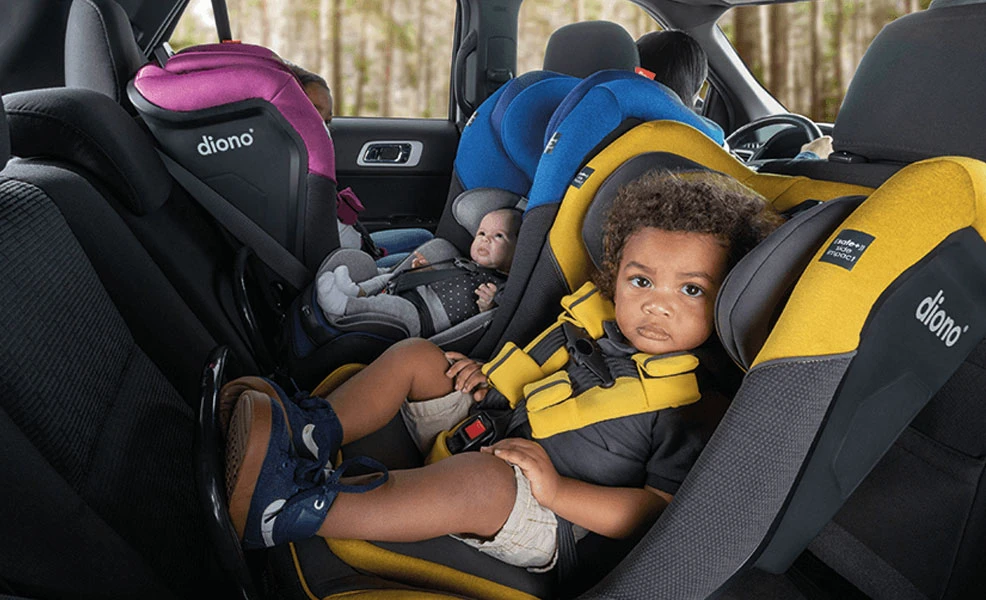
Mommyhood101 independently tests and curates baby gear to help you make informed decisions. If you buy products through links on our site, we may earn a commission.
Trying to fit three car seats in your back seat? Believe it or not, it's entirely possible!
Several leading brands have designed ultra-slim car seats to make it easier to fit multiple seats in a row without compromising comfort or safety (see the research here and side-impact testing information here).
We've been reviewing narrow car seats for over 10 years, and if we built our own, here's what it would include:
✔️ About 17" wide or less.
✔️ Narrowest at the base.
✔️ Elevated seating position.
✔️ Flexible installation options.
✔️ Quick-release LATCH.
✔️ Auto-tightening LATCH.
✔️ Seat belt lock-offs.
✔️ European belt path (infant).
✔️ Energy-absorbing foam.
✔️ Full side impact protection.
✔️ 50-pound rear-facing limit.
✔️ 40-pound LATCH limit.
✔️ Lightweight build (<10 lbs).
Of course, a great narrow car seat should also deliver the same safety, comfort, and convenience as any other top-rated model, all while fitting your family's style and budget.
-
- Narrowest Infant Car Seats
- 1. Clek Liing Infant Car Seat (16.9" wide)
- 2. UppaBaby Mesa V3 (17" wide)
- 3. Nuna Pipa RX (17.5" wide)
- 4. Chicco KeyFit Max (16.7" wide)
- 5. Graco Snugride Snugfit (17.5" wide)
- 6. Cybex Aton G (17" wide)
- 7. Chicco KeyFit 30 (17" wide)
- Narrowest Convertible Car Seats
- 1. Clek Fllo (16.9" wide)
- 2. Diono Radian 3QX & 3QXT (17" wide)
- 3. Britax One4Life Slim (17.5" wide)
- 4. Britax Poplar (17" wide)
- 5. Diono Radian 3R & 3RXT (17" wide)
- 6. Graco SlimFit3 LX (16.7" wide)
- Narrowest Booster Seats
- 1. Chicco MyFit (17.5" wide)
- 2. WayB Pico Booster (14.5" wide)
- 3. Chicco KidFit (19" wide)
- 4. Maxi-Cosi Rodifix Booster (18.5" wide)
- 5. Graco TurboBooster (17" wide)
- Details & Conclusions
Full disclosure: Some of these car seats, including the Mifold, Baby Trend, Diono, Maxi-Cosi, and Graco models, were sent to us as free test samples by the manufacturer.
There are a few things to keep in mind when trying to fit three car seats in a row.
- Choose narrow seats. Aim for models around 17" wide or less to maximize space.
- Plan the layout. Decide which seats will go in the center and outboard positions for easiest access and buckling.
- Check your backseat. Identify which positions have LATCH anchors and whether your kids still qualify to use them.
- Test the fit! Every vehicle and car seat is different. Try installing all three seats to see what truly works with your setup. If you have a friend with the car seats, borrow them for 15 minutes to test the setup!
There is always some guesswork involved in this process, so we identified car seats that are not only narrow but also have very flexible installation.
The Top 5 Narrowest Infant Car Seats of 2025
Or jump to Narrowest Convertible Car Seats.
Or jump to Narrowest Booster Car Seats.
For rating the narrowest infant car seats, we combine the results from our typical car seat tests with the extent to which the car seat is not only narrow but also capable of flexibly achieving a secure installation.
| ★★★★★★★★★★ (10/10) | At just 16.9" wide, this is one of the slimmest infant car seats on the market and our favorite narrow car seat pick of all time. The Liing features a metal load leg built into the base to reduce rebound and crash forces in a collision, supports European belt path installation (installing without the base), has exceptional crash-test ratings, and its high seating position helps parents access seat belt buckles and LATCH connectors. | CHECK PRICES | READ FULL REVIEW | |
| ★★★★★★★★★★ (10/10) | A premium 17"-wide infant car seat featuring an upgraded full-coverage canopy, the trusted SMARTSecure® installation system, a no-rethread harness, and GREENGUARD® Gold-certified, flame-retardant-free fabrics. With its seamless stroller compatibility and refined design, the Mesa V3 is an excellent choice for parents who want safety, style, and convenience in one compact seat! | CHECK PRICES | READ FULL REVIEW | |
| ★★★★★★★★☆☆ (8/10) | At 17.5″ wide and only 7.6 lbs, the Nuna PIPA RX offers premium safety and design with its RELX™ base, rigid LATCH, load leg, and anti-rebound panel. Its flame-retardant-free, GREENGUARD Gold-certified fabrics and Dream Drape™ canopy add comfort and style, though a no-rethread harness would make this premium seat even better. | CHECK PRICES | READ FULL REVIEW | |
| ★★★★★★★★☆☆ (8/10) | A 16.7″-wide infant car seat with effortless installation, a built-in anti-rebound bar, and a height limit up to 32″. The new KeyFit Max combines safety, comfort, and compact design at a very reasonable price, making it an excellent choice for smaller vehicles or families needing to fit multiple seats across. | CHECK PRICES | READ FULL REVIEW | |
| ★★★★★★★★☆☆ (8/10) | One of the best budget-friendly narrow options at only 17.5" wide. Features SnugLock installation, no-rethread harness, and a surprisingly lightweight build at this price point. | CHECK PRICES | READ FULL REVIEW |
For more comprehensive reviews of these models, going beyond the ability to fit three car seats in a row, be sure to check out our reviews of this year's best infant car seats!
In-Depth Reviews of the Narrowest Infant Car Seats
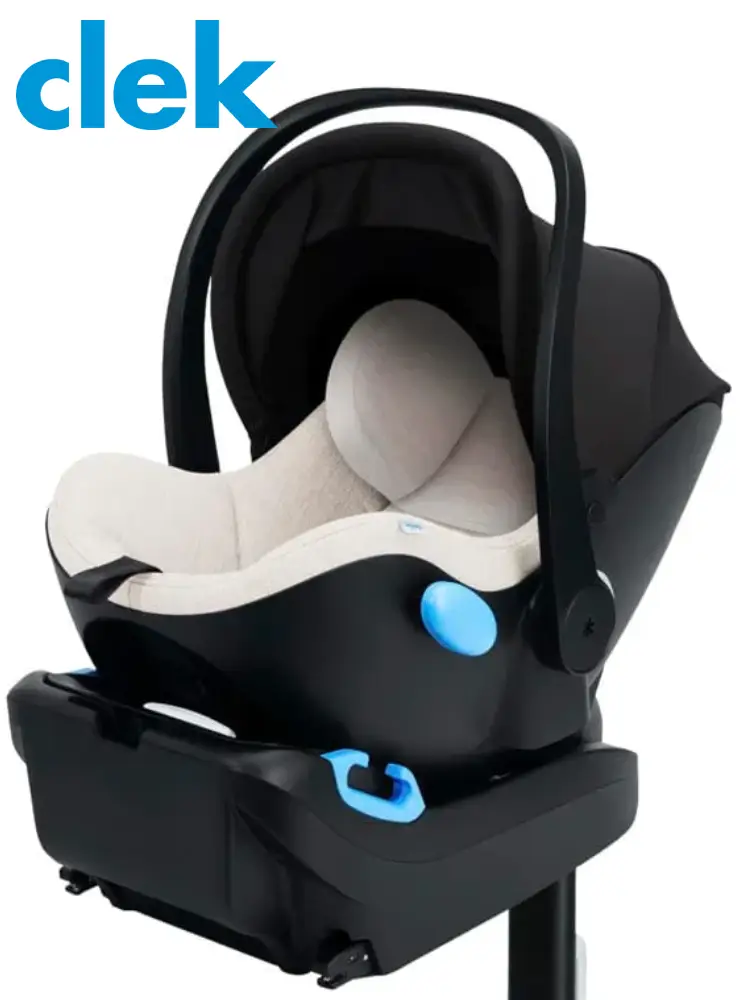
1. Clek Liing Infant Car Seat (16.9" wide).
If you don't know Clek, you're about to meet your new best friend for fitting three car seats in a row! Based in Canada, Clek designs and manufactures its entire lineup in North America, including the Liing (infant), Foonf and Fllo (convertibles), and Oobr (booster). All Clek seats are known for exceptional safety, quality, and style. The Clek Liing is among the narrowest infant car seats available, measuring just 16.9" wide with a 13.2" base. The slim profile and high seating position (27" from base to handle) make it easier to access buckles and fit multiple seats side-by-side.
When using LATCH, the Liing’s rigid connectors deliver rock-solid stability but are limited to positions with standard 11" spacing, typically restricting it to the outboard seats in most vehicles. Some newer SUVs and minivans include center LATCH anchors, so check your vehicle manual if you plan to install the Liing in your center seat. When installed with a seat belt, Clek’s integrated belt tensioner (lock-off) provides a tight and secure fit with minimal effort. Without the base, the seat supports European belt path installation for travel, ride-sharing, or taxis.
All these design details, including the narrow frame, belt lock-offs, and raised seating, make the Liing an excellent choice for fitting three across. And it'll last in that position: the Liing accommodates infants from 4–35 lbs (with a two-stage infant insert) and up to 32" tall, or until the head is within 1" of the top of the headrest. The Liing’s 9-year lifespan, exceptional crash-test performance, load leg that reaches even tall vehicle floors, and finely adjustable recline system set it apart from the others. It also offers outstanding side-impact protection, energy-absorbing EPP foam, and luxurious C-Zero or Merino Wool fabrics that are free of flame retardants. Despite its robust feature set, the Liing weighs only 9 lbs! The only drawback is the manually re-threaded harness, which takes a bit more effort to adjust. Otherwise, the Clek Liing is one of the most compact, safe, and premium infant seats you can buy. Needless to say, we love it! So do experts at Consumer Reports, The Car Seat Lady, and CSFTL. Interested? You can check out the Clek Liing here.

2. UppaBaby Mesa V3 Infant Car Seat (17" wide).
The UPPAbaby Mesa V3 is the newest version of the popular Mesa infant car seat, building on the strengths of the V2 with thoughtful upgrades to comfort, materials, and protection. Updates include a premium full-coverage UPF 50+ canopy with magnetic mesh ventilation, refined GREENGUARD® Gold-certified fabrics, and an enhanced adjustable headrest that offers up to 25 positions for a perfect fit as your baby grows. Together with the trusted SMARTSecure® installation system and a sleek, modern design, the Mesa V3 continues to stand out as one of the safest and most user-friendly infant car seats on the market. Couple that with its slim profile and you've got a winning combination for families looking for a narrow fit! The Mesa V3 measures about 17″ wide (at the carry handle) with a 15.5″ wide base, and the carrier itself weighs only 9.9 pounds, making it lightweight and easy to transport. Note that the new UppaBaby Aria model is even lighter at 5.9 pounds, but has a maximum child height of only 30" (the Mesa V3 supports little ones up to 32" tall or 30 pounds).
Don’t let its slim and low-profile design fool you, the Mesa V3 packs serious safety and convenience features: robust side-impact protection with energy-absorbing EPP foam, a no-rethread harness, and improved comfort padding throughout. The SMARTSecure® installation system remains one of the best in the business, allowing a rock-solid installation in about 30 seconds. Its four-position leveling foot, built-in seatbelt lock-offs, and auto-retracting LATCH system make installation quick, simple, and virtually error-proof. In our testing, we were able to fit three Mesa V3 seats side-by-side in midsize SUVs like the RAV4, CR-V, MDX, and Forester. It’s a tight squeeze, but definitely achievable with careful placement. As with previous models, the Mesa V3 also supports European belt routing for baseless installations, perfect for travel, taxis, or rideshares. We love the premium feel, improved ventilation, intuitive installation, and narrow footprint of the Mesa V3. The only downside? A premium price tag and a weight limit of 30 pounds. But for families who want one of the safest, easiest, and most stylish infant seats available, it’s well worth it. Interested? You can check out the UPPAbaby Mesa V3 here!
What's new in the Mesa V3 versus V2?
- Upgraded canopy: Full-coverage UPF 50+ canopy with magnetic mesh ventilation window for better airflow and sun protection.
- Refined materials: Premium GREENGUARD® Gold-certified fabrics with a softer, more breathable feel.
- Enhanced headrest: New 25-position adjustable headrest offers a more precise fit and improved side-impact protection.
- Modernized design: Subtle styling updates and color options for a more streamlined, premium look.
- Same easy install: Retains the trusted SMARTSecure® system with auto-tightening LATCH and visual tension indicator.
- Slightly lower weight limit: Now rated for up to 30 lbs (instead of 35 lbs on the V2), though overall height limit remains 32 inches.
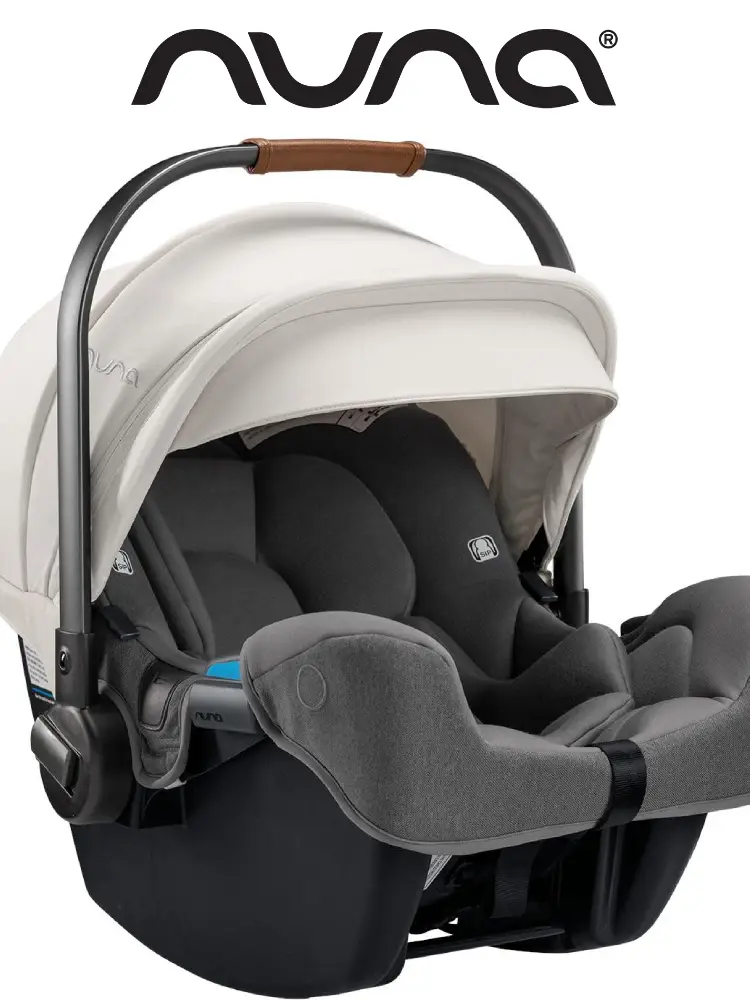
3. Nuna PIPA RX Infant Car Seat (17.5" wide).
Up near the top of our best infant car seat list is the stunning Nuna PIPA RX, which combines sophisticated design, premium materials, and top-tier safety. Nuna’s infant and convertible seats (the PIPA series and the RAVA) are both exceptionally well-reviewed by parents and safety experts alike, including Babylist, What to Expect, and The Bump. The PIPA RX is one of the narrowest premium infant car seats available, measuring only 17.5" wide with a 12.2" base, making it an excellent choice for compact vehicles or multi-seat setups. Its tall profile (about 26" from the bottom of the base to the top of the handle) helps create hand clearance for buckling when seats are positioned close together.
Installation is handled through Nuna’s innovative RELX™ base, which includes rigid LATCH connectors, a built-in anti-rebound panel, four-position recline adjustment, and a load leg that stabilizes the seat and helps absorb crash forces. The rigid LATCH system provides one of the most secure installs we’ve seen, but note that it’s limited to seating positions with standard 11" anchor spacing; most families will need to use the outboard positions for LATCH installs, unless your vehicle happens to have center anchors. For the center position or vehicles without anchors, the PIPA RX can be installed using the seat belt and integrated lock-off. Without the base, it also supports European belt path installation, making it ideal for travel or ride-shares.
The Nuna PIPA RX supports infants from 4 to 32 pounds and up to 32" tall, and the carrier weighs only 7.6 pounds, which is remarkably light for a seat with this feature set. Safety features include a crumple zone within the base and load leg, EPS energy-absorbing foam, and robust side-impact protection. Comfort and aesthetics are also outstanding: the huge Dream Drape canopy provides full-coverage sun and nap protection, and the flame-retardant-free fabrics (many with Merino wool options) are soft, breathable, and GREENGUARD Gold-certified. The only notable drawback is that the PIPA RX still uses a rethread harness rather than a no-rethread system: a minor drawback, but worth mentioning at this price point. Overall, the Nuna PIPA RX offers exceptional safety, ease of use, and elegance in a compact 17.5" design. Interested? You can check out the Nuna PIPA RX here.
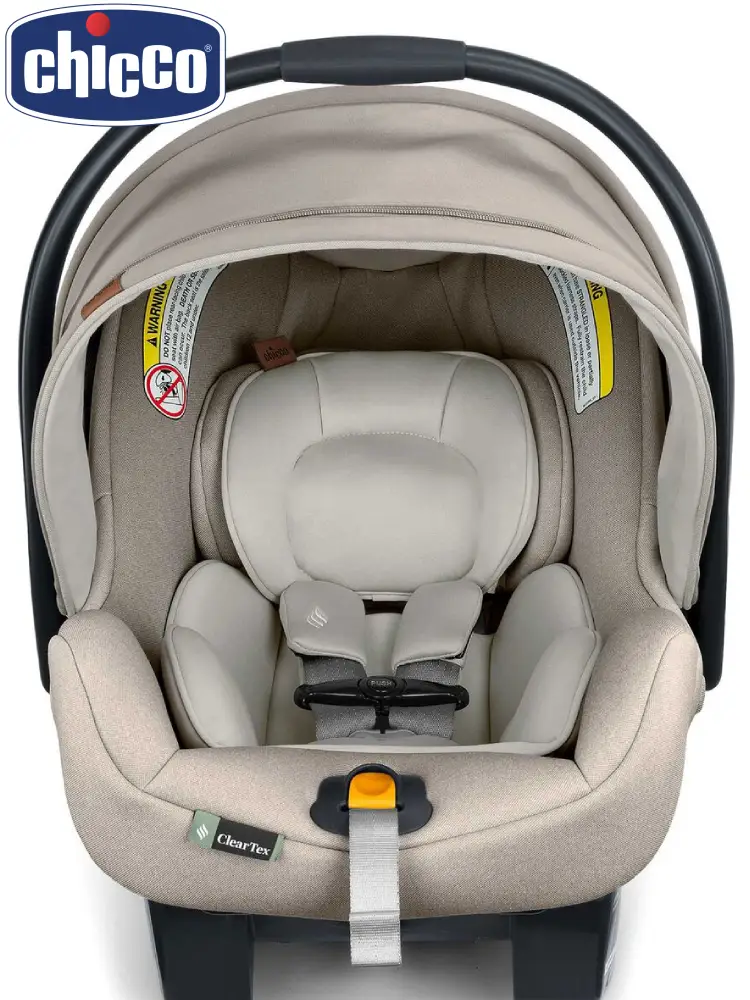
4. Chicco KeyFit Max Infant Car Seat (16.7" wide).
The Chicco KeyFit line has long been a gold standard for infant car seats, and the new KeyFit Max takes everything parents love about the original and adds premium upgrades. Designed for safety, comfort, and ease of installation, the KeyFit Max combines Chicco’s proven engineering with modern ClearTex™ flame-retardant-free fabrics and GREENGUARD Gold certification. At about 16.7″ wide with a 15″ base, it’s one of the narrowest mainstream infant car seats on the market, making it perfect for smaller vehicles or fitting three seats across.
The KeyFit Max supports infants from 4 to 30 pounds and up to 32″ tall, offering slightly more headroom and legroom than the original KeyFit 30. Its redesigned base includes an integrated anti-rebound bar and lock-off belt system for secure installation, whether using LATCH or the vehicle’s seat belt. As with all Chicco seats, installation is a breeze thanks to the SuperCinch® LATCH tightener: just pull the single strap while pressing down on the base for a rock-solid fit. While it uses flexible (strap-based) LATCH rather than rigid connectors, this actually helps achieve tighter spacing in three-across setups.
Without the base, the KeyFit Max allows both American and European belt routing, adding flexibility for taxis, travel, or second vehicles. Safety features include EPS energy-absorbing foam, side-impact protection, and the anti-rebound bar to limit rotation in a crash. The ClearTex™ upholstery is soft, breathable, and chemical-free, while premium versions (like the Zip ClearLux) add zip-off covers, a ventilated canopy, and magnetic harness holders. At about 10.5 pounds, it’s slightly heavier than ultra-light competitors like the Nuna PIPA RX or Clek Liing, but it delivers outstanding safety and convenience at a much lower price point, coming in around $250. For families seeking a narrow, high-value seat with easy installation and exceptional quality, the KeyFit Max is one of our top recommendations. Interested? You can check out the Chicco KeyFit Max here!
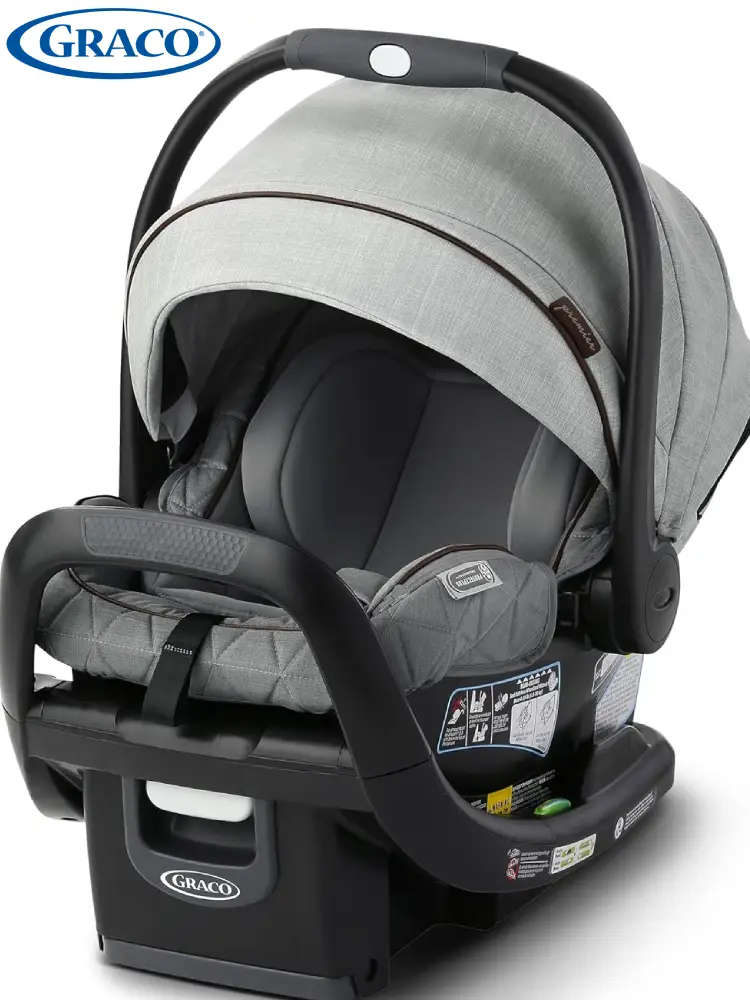
5. Graco SnugRide SnugFit DLX Infant Car Seat (17.5" wide).
The Graco SnugRide has been one of the most trusted infant car seat lines for decades, known for reliability, safety, and value. Their latest SnugRide SnugFit DLX car seat continues that legacy with updated safety features, improved materials, and one of the easiest installations in its class. Measuring about 17.5″ wide with a slim 13.5″ base, it’s a great fit for compact vehicles or even three-across configurations in many midsize SUVs. The DLX version includes Graco’s SnugLock® installation system, which uses a swing-arm to tension and lock the seat belt, ensuring a rock-solid and level installation in under a minute; perfect for tight spots where seats can shift near the doors.
For LATCH installations, the InRight™ LATCH system makes attachment quick and easy, though we still recommend pushing down on the base (or sitting on it) while tightening the straps for the most secure fit. The included anti-rebound bar significantly improves stability and reduces rotation during a crash, bringing the SnugFit DLX closer in safety to more premium models. Other standout safety features include Graco’s ProtectPlus™ engineering for frontal, side, rear, and rollover protection, as well as EPS energy-absorbing foam. The no-rethread harness and adjustable headrest make it easy to accommodate growing infants without hassle.
The SnugFit DLX supports babies from 4 to 30 pounds and up to 32 inches tall. At about 9.8 pounds for the carrier, it’s heavier than others (like the Nuna PIPA RX) but still manageable for everyday use. While it doesn’t offer a load leg like some higher-end seats, its strong safety record, user-friendly installation, and accessible price (usually around $230–$250) make it one of the best value options on the market. Interested? You can check out the Graco SnugRide SnugFit DLX here!
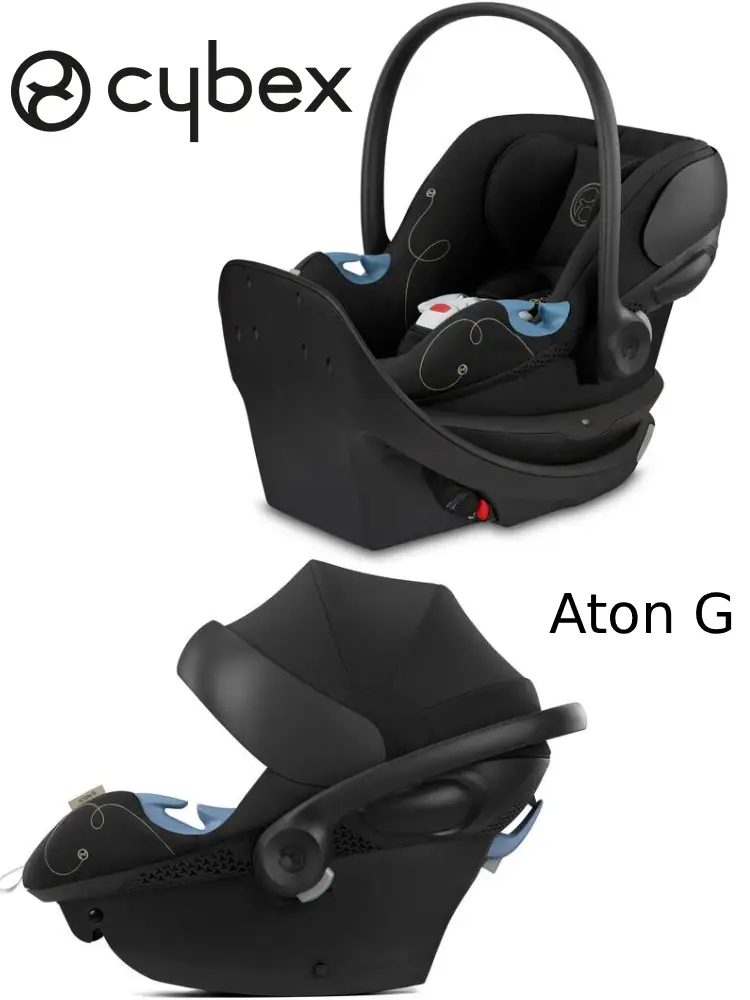
6. Cybex Aton G Infant Car Seat (17.5" wide).
The Cybex Aton G is an ultra-light, European-designed infant car seat that blends modern styling, premium materials, and advanced safety engineering in a narrow, easy-to-carry package. At just about 17.5″ wide, it’s a strong choice for families needing a compact seat that still delivers high-end safety and comfort. Its sleek shell and narrow base make it compatible with tight backseat spaces or three-across setups, while its sculpted design and plush padding showcase Cybex’s attention to detail and ergonomics. At 17.5" wide it's not as narrow as its competitors. In most scenarios, that extra 0.25" on each side won't make a dramatic difference, unless you have a compact car or midsize sedan.
The Aton G supports infants from 4 to 35 pounds and up to 32″ tall, offering slightly more height range than most competitors. Weighing only about 9 pounds, it’s one of the lightest premium infant seats available. The base features an integrated anti-rebound bar for stability, built-in seat belt lock-offs for easy and secure installation, and a smooth five-position recline to achieve the proper angle. Installation can be done with either the vehicle seat belt or the flexible LATCH system, and like all car seats, Cybex recommends using only the dedicated center LATCH anchors (with proper 11″ spacing) if present, or otherwise relying on the seat belt for center installations.
Safety features include Linear Side-Impact Protection (L.S.P.), energy-absorbing foam, and a well-ventilated shell to help manage temperature and airflow. The Aton G has excellent crash-test performance and solid real-world stability thanks to its anti-rebound base design. However, it does lack a load leg (something included in earlier Aton 2 and Cloud G models), and it does not offer the SensorSafe system found on higher-tier Cybex seats. The canopy provides decent coverage, though it’s smaller than what you’ll find on other premium narrow infant car seats. Overall, the Aton G is an ideal option for parents who value a lightweight, stylish, and compact car seat that doesn’t compromise on safety or build quality. It typically sells for around $250–$300, including the base. Interested? You can check out the Cybex Aton G here!
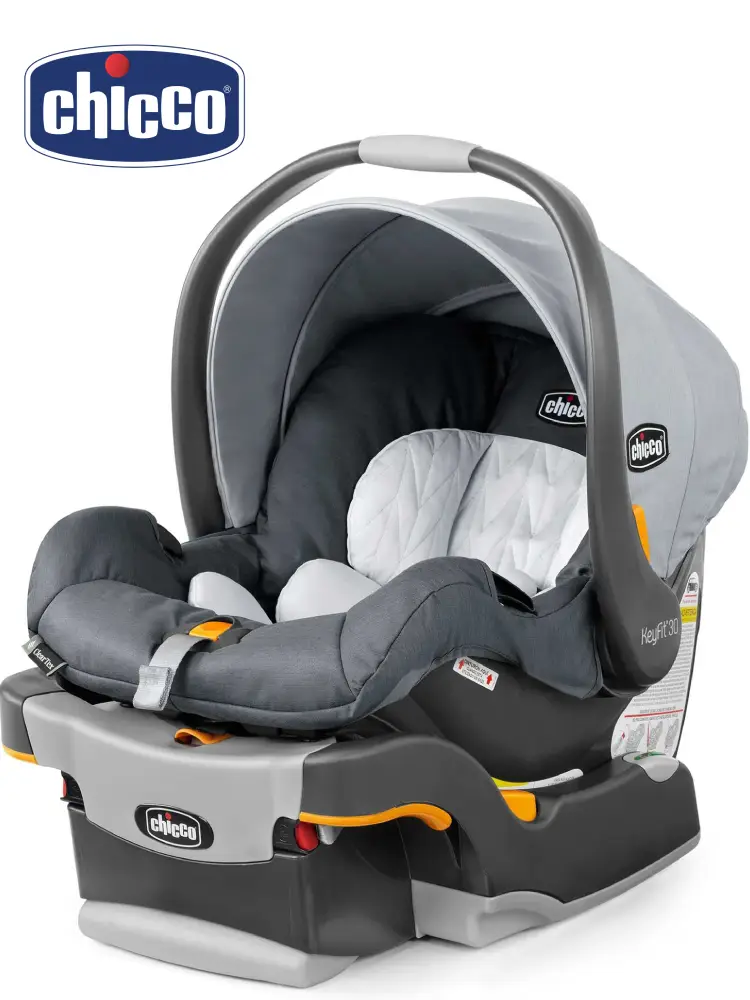
7. Chicco KeyFit 30 Infant Car Seat (16.5" wide).
The Chicco KeyFit 30 and 35 are the most popular and trusted infant car seats ever made, consistently praised for safety, simplicity, and reliability. At about 16.5″ wide with a 15″-wide base and weighing roughly 9.5 lbs, it’s a compact and manageable choice that works beautifully in smaller vehicles or three-across configurations. It’s not the newest seat on the market, but its outstanding real-world performance and intuitive installation have made it a long-time favorite for us, fellow parents, and safety experts alike.
Installation is where the KeyFit 30 really shines. The base features Chicco’s SuperCinch® LATCH tightener, ReclineSure® leveling foot, and RideRight® bubble level indicators, which make it easy to achieve a snug, correct fit in almost any vehicle. The seat can also be installed using the vehicle seat belt and built-in lock-offs for flexibility. While the base doesn’t include an anti-rebound bar or load leg like newer premium models, it remains extremely stable when installed correctly. The flexible (non-rigid) LATCH system also helps with installation in tight spaces or uneven seating positions.
The KeyFit 30 supports infants from 4 to 30 pounds and up to 30″ tall. Because of the 30″ height limit, most babies will outgrow this seat in height before reaching the weight limit. Safety features include EPS energy-absorbing foam, side-impact protection, and a sturdy shell that has performed exceptionally well in independent crash testing. The harness requires manual re-threading to adjust height, which is typical for this price range. The canopy is on the smaller side, but the overall build quality and fit-to-vehicle make this seat an outstanding value at around $200. For families wanting similar ease-of-use and width, but with more height room and an anti-rebound bar, Chicco’s KeyFit 35 is a great next-step option (at a slightly higher price). Interested in the KeyFit 30? You can check out the KeyFit 30 here!
The Top 5 Narrowest Convertible Car Seats of 2025
Or jump to Narrowest Booster Seats.
A convertible car seat supports infants and toddlers in a rear-facing harnessed position, and then transitions to a front-facing harnessed mode.
Some also transition to a belt-positioning booster and beyond.
Here are the top 5 narrow convertible car seats we've tested, followed by full reviews of several options.
| ★★★★★★★★★★ (10/10) | At only 16.9" wide, the Canada-made Fllo and Foonf are among the narrowest convertible seats available. The Fllo stands out for its flexible LATCH options, steel-reinforced frame, and 50-lb rear-facing limit, making it perfect for tight 3-across setups. | CHECK PRICES | READ FULL REVIEW | |
| ★★★★★★★★★★ (10/10) | At 17" wide, the 3QX and 3QXT combine premium safety and slim design. Rear-face up to 50 lbs, forward-face to 65 lbs, and convert to a high-back booster up to 120 lbs. Excellent steel frame strength and upgraded side-impact protection make them ideal for 3-across. | CHECK PRICES | READ FULL REVIEW | |
| ★★★★★★★★★★ (10/10) | A 17.5" wide all-in-one seat with ClickTight installation, a 5–120 lb range, and exceptional side-impact protection. Built with a steel frame and SafeCell technology, it’s one of the safest and most durable narrow seats for long-term use. | CHECK PRICES | READ FULL REVIEW | |
| ★★★★★★★★★★ (10/10) | At just 17" wide, the Poplar offers Britax’s trusted ClickTight system, a 50-lb rear-facing limit, and flame-retardant-free fabrics. It’s sturdy, comfortable, and incredibly easy to install, making it perfect for families fitting multiple seats across. | CHECK PRICES | READ FULL REVIEW | |
| ★★★★★★★★★☆ (9/10) | At 17" wide, the Radian 3R series is a classic for tight installations. Each features a steel-reinforced frame, EPS energy-absorbing foam, and extended rear-facing support. A bit tall and heavy, but still one of the best 3-across options on the market. | CHECK PRICES | READ FULL REVIEW |
The narrowest convertible car seats tend to be about 17" wide.
Beyond assessing the width, we assessed whether the seat can achieve a very secure installation with both LATCH and the vehicle's seat belt since you'll likely be transitioning away from LATCH around your child's third or fourth birthday (due to weight limits).
For more options, check out our full list of the best convertible car seats.
In-Depth Reviews of the Narrowest Convertible Car Seats
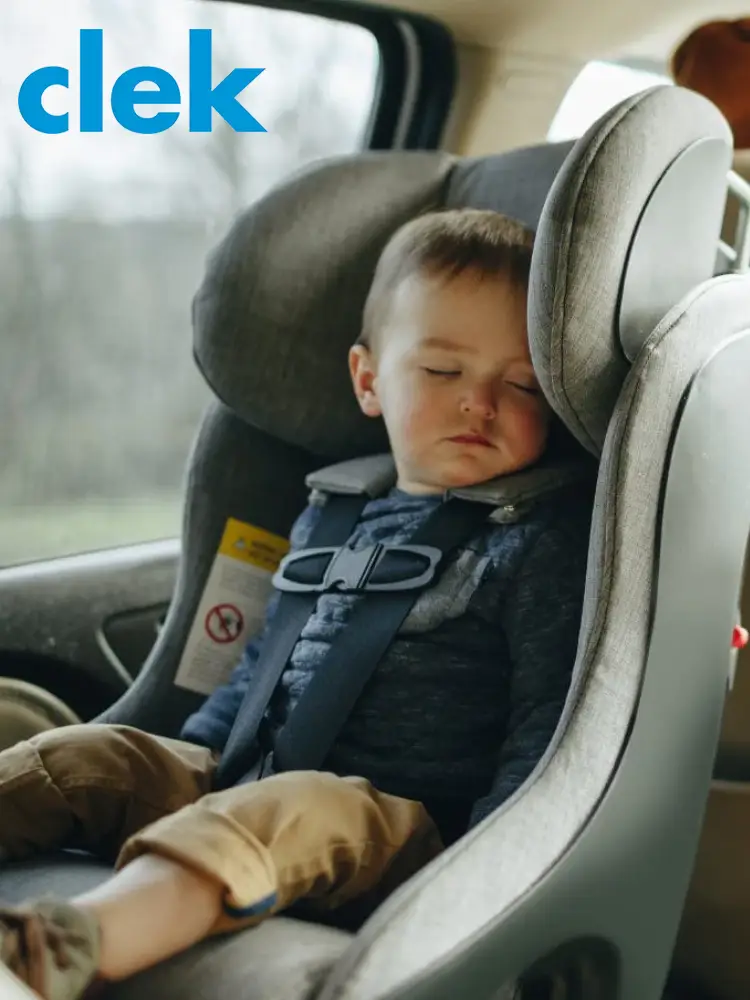
1. Clek Fllo Convertible Car Seat (16.9" wide).
The Clek Fllo is one of the narrowest and most premium convertible car seats available, measuring only 16.9″ wide and designed for exceptional safety, comfort, and style. Made in Canada, it features advanced safety systems and eco-friendly materials that meet some of the highest quality standards in the industry. The Fllo can be installed rear-facing or forward-facing and includes an integrated anti-rebound bar for added stability when rear-facing.
At about 25 pounds, the Fllo is roughly 10 pounds lighter and slightly more compact than its more expensive sibling, the Clek Foonf, while offering nearly identical safety and comfort features. It uses a flexible, strap-based LATCH system for both rear- and forward-facing installations, which we found made it more adaptable in tight seating configurations and easier to install in a variety of vehicles. Once your child reaches 40 pounds, Clek recommends switching to a seat belt installation, which works seamlessly with the Fllo’s secure belt lock-offs.
The Fllo supports children from 14 to 65 pounds (or from birth with Clek’s optional Infant Thingy insert) and up to 49″ tall. It allows extended rear-facing use up to 50 pounds, which is an impressive safety advantage. Additional highlights include energy-absorbing EPP foam, a steel anti-rebound bar, and a deep side-impact protection system with a reinforced headrest. Premium fabrics, including Merino Wool and C-Zero Plus performance textiles, are free of added flame retardants. The Fllo’s light weight, flexibility, and lower price (versus the Foonf) make it a very practical choice for most families, especially when fitting multiple car seats in a row. We love it, and so do our friends at Babylist, WhatToExpect, and BabyGearLab. Interested? You can check out the Clek Fllo here!
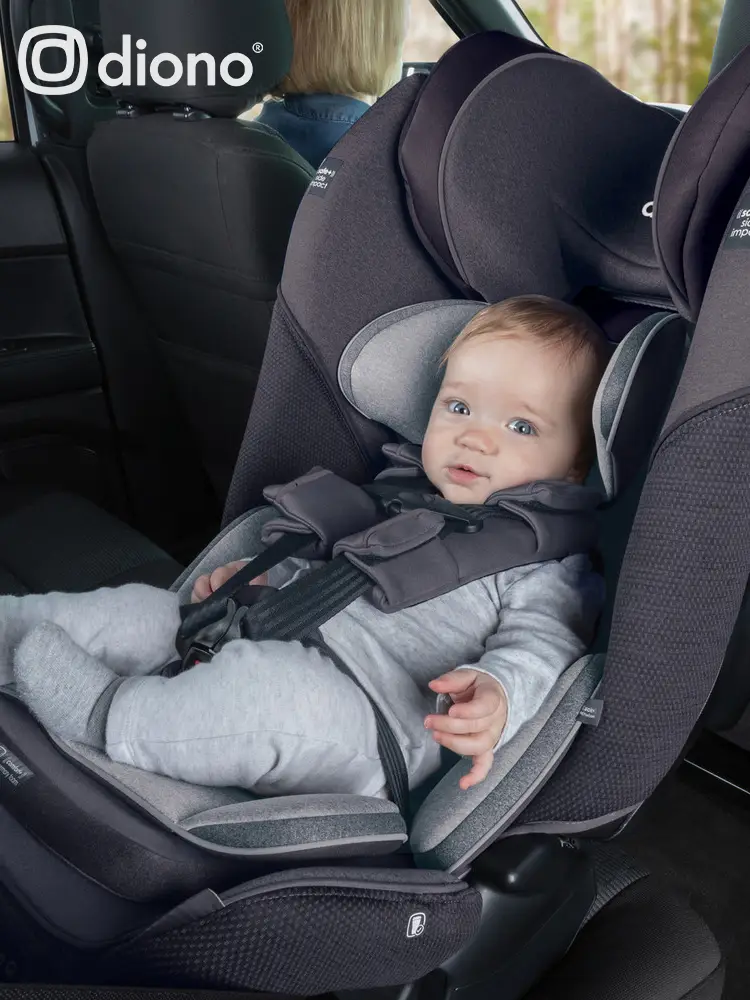
2. Diono Radian 3QX and 3QXT Convertible Car Seats (17" wide).
The Diono Radian series is one of the most popular narrow lines of convertible car seats on the market, designed specifically for fitting three across in most mid-size vehicles. Measuring just 17″ wide, the Radian 3QX combines an incredibly slim footprint with Diono’s signature steel-reinforced frame, anti-rebound bar, and SafePlus™ engineering for advanced crash protection. Built as an all-in-one seat, it accommodates children from 4–50 lb rear-facing, 22–65 lb forward-facing with harness, and up to 120 lb in booster mode, giving it a full decade of use.
The 3QX is especially impressive in tight back seats. Its narrow shell, straight sides, and low-profile base allow three seats to fit comfortably across without compromising installation security. Rear-facing, it’s best suited for larger vehicles due to its tall seatback and recline angle, but forward-facing it fits beautifully in nearly any setup. In our testing, installation was very straightforward using either LATCH (up to 35 lb rear-facing) or the vehicle seat belt, and Diono’s visual angle indicators made proper recline easy to verify. We love how the seat folds flat for travel or storage, something few convertible seats can do.
In terms of comfort and safety, the Radian 3QX features Diono’s SafePlus™ side-impact protection system, a 12-position adjustable headrest, and a redesigned SafePlus™ newborn insert for better infant fit. The 3QXT adds a few luxuries over the 3QX, including additional side-impact layers and extra infant protection inserts for smaller babies. For families who want it all, the 3QXT+ even includes an extendable leg rest for forward-facing comfort. All three maintain the same slim 17″ width, making them among the best choices for multi-seat families who don’t want to compromise on safety or style. Interested? You can check out the Diono Radian 3QX here and use coupon code DIONOGIVE20 for 20% off your order!
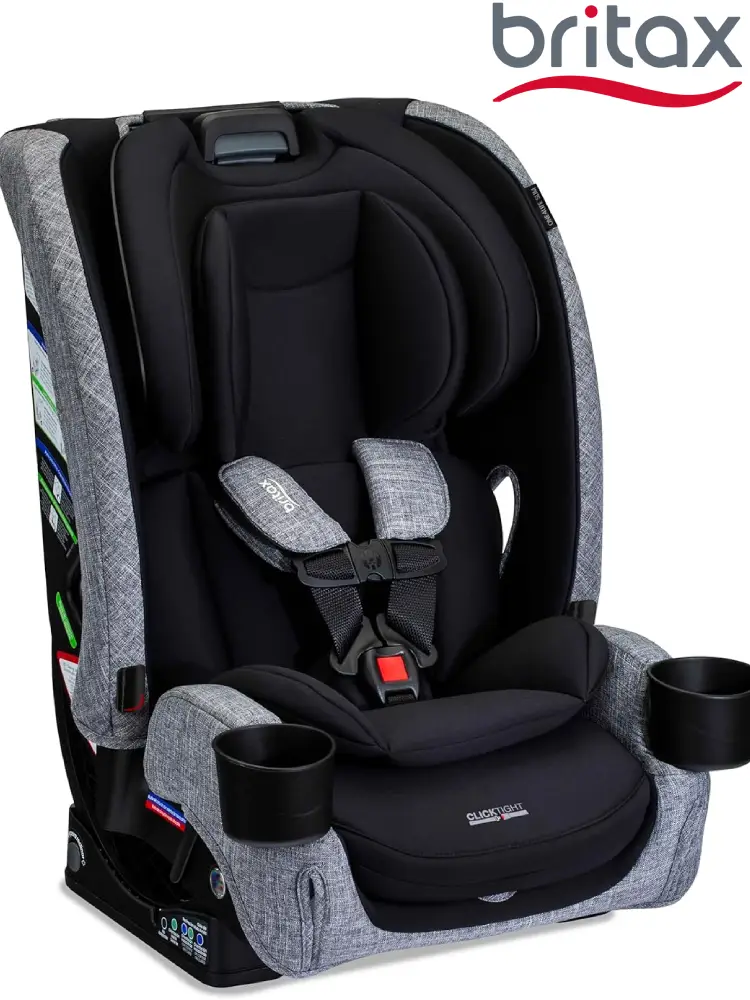
3. Britax One4Life Slim All-in-One Car Seat (17.5" wide).
The Britax One4Life Slim is the new, narrower version of Britax’s best-selling all-in-one car seat, designed to fit three across while maintaining the comfort, safety, and longevity the One4Life line is known for. It transitions from a rear-facing seat (5–50 lb) to a forward-facing harness seat (22–65 lb), and finally to a belt-positioning booster (40–120 lb), making it truly one seat for all stages of growth. Measuring about 17.5″ wide, the Slim model trims over two inches from the original One4Life, making it much easier to fit side-by-side with other seats in most midsize vehicles.
In our testing, easy installation was a highlight thanks to Britax’s ClickTight® system, which allowed us to secure the seat quickly and confidently using the vehicle’s seat belt, with no wrestling required! The steel-reinforced frame, SafeCell® crumple zone, and energy-absorbing shell work together to provide excellent protection in a crash. For comfort, the One4Life Slim offers nine recline positions, a 15-position headrest and harness system that adjusts without rethreading, and breathable fabric with built-in ventilation channels.
In our hands-on testing, we found the One4Life Slim’s build quality and installation process to be outstanding. The ClickTight system made it easy to get a rock-solid install, and the slim profile allowed three seats to fit comfortably across in our midsize SUV, a major win for families with multiple kids. At around 26.5 pounds, it’s on the heavier side, and we’d love to see Britax include quick-release LATCH connectors for easier switching between vehicles. Still, the One4Life Slim delivers an impressive combination of safety, comfort, and long-term value, making it one of the best full-featured narrow car seats on the market. Interested? You can check out the Britax One4Life Slim here.
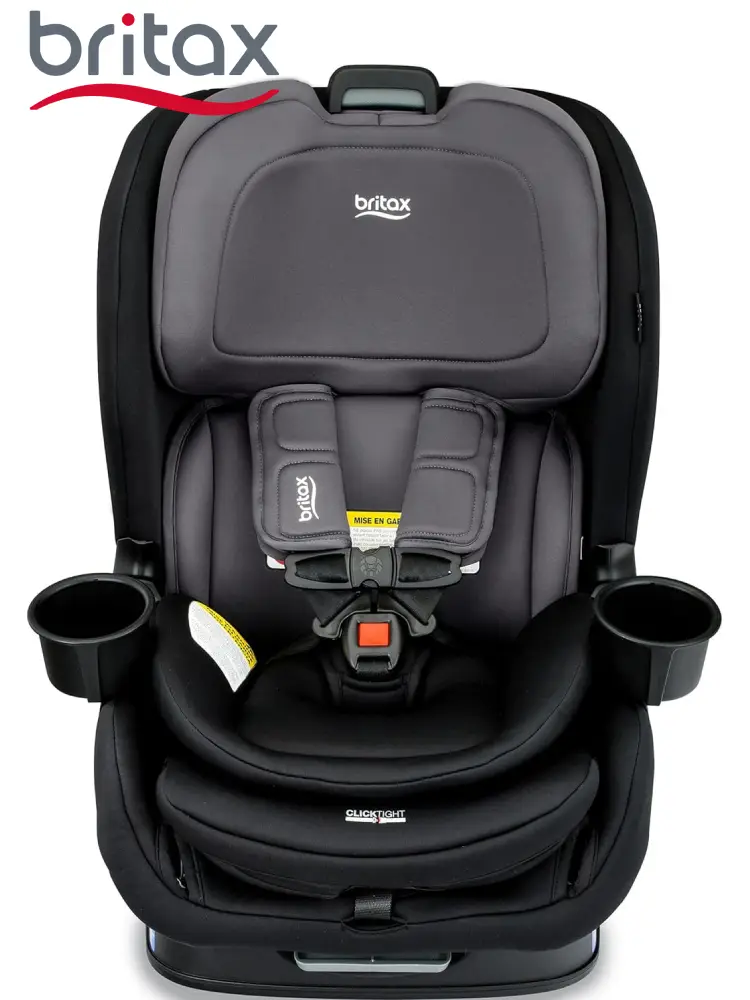
4. Britax Poplar Convertible Car Seat (17" wide).
The Britax Poplar is Britax’s newest convertible car seat, and we’re thrilled to see them finally tackle the “narrow seat” challenge without compromising their signature safety and comfort. At just about 17″ wide (or roughly 19″ with the cup holders attached), the Poplar manages to pack in Britax’s industry-leading safety technologies into a slimmer, more space-efficient design. It weighs around 27 pounds and features a steel-reinforced frame, SafeCell® crumple zone, energy-absorbing shell, and ClickTight® installation system. These are all hallmarks of Britax's superior engineering. Rear-facing, it supports children from 4 to 50 pounds (up to 49″ tall), and forward-facing from 22 to 65 pounds.
In our hands-on testing, the Poplar impressed us with how well it balanced sturdiness and usability. The ClickTight installation system made setup exceptionally easy, especially when installing three seats across. Instead of struggling to reach between neighboring car seats, we simply lifted the base panel, routed the seat belt along the guides, and pressed the panel back down, producing one of the most secure installs we’ve ever tested! The 6-position recline and 15-position headrest (with a no-rethread harness) made it easy to dial in a perfect fit for different ages, while plush padding, breathable fabrics, and thoughtfully placed harness covers kept our little tester comfortable on long drives. At 17" wide, it's basically as narrow as a convertible car seat can get. When you attach the cup holders, it widens the overall frame by about 2", which is important to keep in mind if you have several convertible car seats adjacent to each other and also facing the same direction.
Made in the USA with flame-retardant-free fabrics and a removable, dishwasher-safe cup holder, the Britax Poplar is a fantastic choice for families looking to fit multiple car seats in a row without sacrificing quality or convenience. It’s not the lightest convertible seat on this list, but the space savings, safety features, installation ease, and long-term usability make it a real standout. We think the Poplar is one of the best all-around narrow convertible car seats of the year. Interested? You can check out the Britax Poplar here.
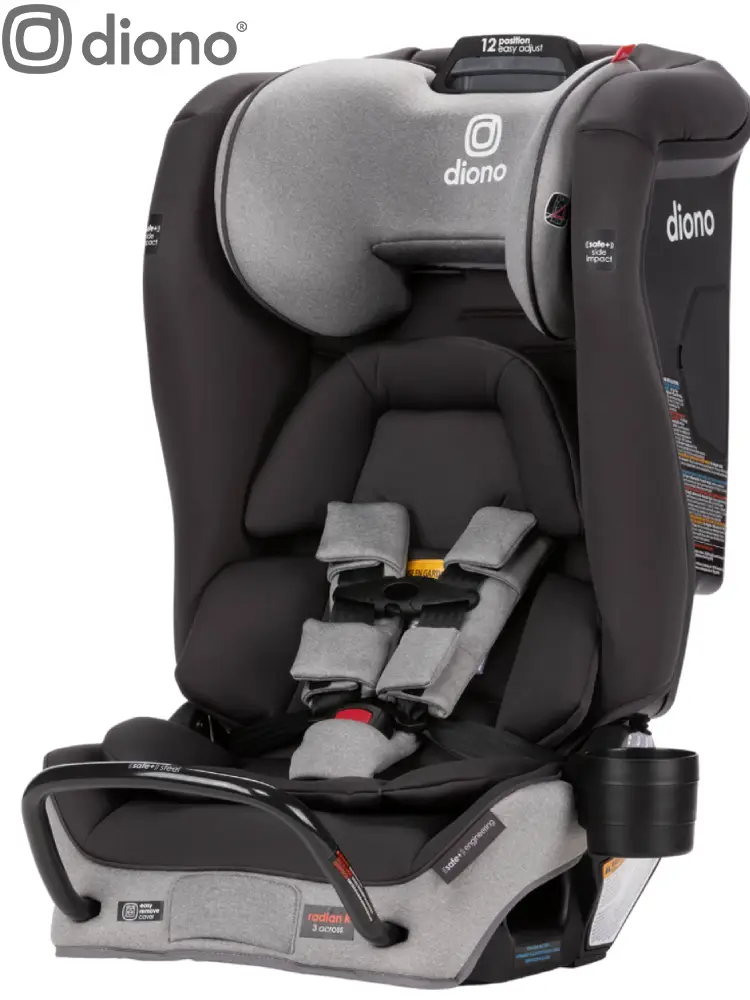
5. Diono Radian 3R, 3RX, and 3RXT Convertible Car Seats (17" wide).
The Diono Radian 3R series continues the brand’s legacy of safety, comfort, and versatility in one of the slimmest convertible car seats on the market. The 3R, 3RX, and 3RXT all share the same 17″ width and signature steel-reinforced frame, allowing families to fit three car seats in a row without compromising protection or comfort. Each model grows with your child from rear-facing (4–50 lb) to forward-facing (22–65 lb) and then converts to a high-back booster (up to 120 lb). The main differences lie in their rear-facing weight limits: 40 lb for the 3R, 45 lb for the 3RX, and 50 lb for the 3RXT. They also have a few key comfort and safety upgrades. We recommend the 3RXT for its infant insert, adjustable no-rethread headrest, enhanced side-impact protection, and cup holders, which together make it the best long-term investment.
In our hands-on testing, the Radian’s steel frame inspired confidence in safety but also made it one of the heaviest convertible car seats we've tested, at about 28 pounds. Rear-facing installation can be done using strap-based LATCH connectors or the vehicle’s seat belt, though because the seat itself is so heavy, the LATCH is limited to a child weighing 35 pounds. We found the ClickTight-style belt tensioning system absent here, so achieving a snug belt install takes a bit more patience, especially when space is tight. Rear-facing, the Radian is quite tall and tends to extend far into the front passenger area, which is something to consider if legroom is limited. Forward-facing installation, however, was much more straightforward and stable, making the Radian an excellent long-term choice once your child outgrows rear-facing mode.
What makes the Radian line truly shine is its ability to fit three across while providing exceptional safety features: a steel alloy frame, EPS energy-absorbing foam, and SafeStop harness system. For families juggling multiple car seats, few models offer this level of protection in such a slim footprint. We especially loved how the 3RXT balanced durability with comfort during testing, feeling premium without being bulky. If you can handle the weight and depth, the Radian 3RXT remains one of the best narrow convertible car seats available today. Interested? You can check out the Diono Radian 3RXT here.
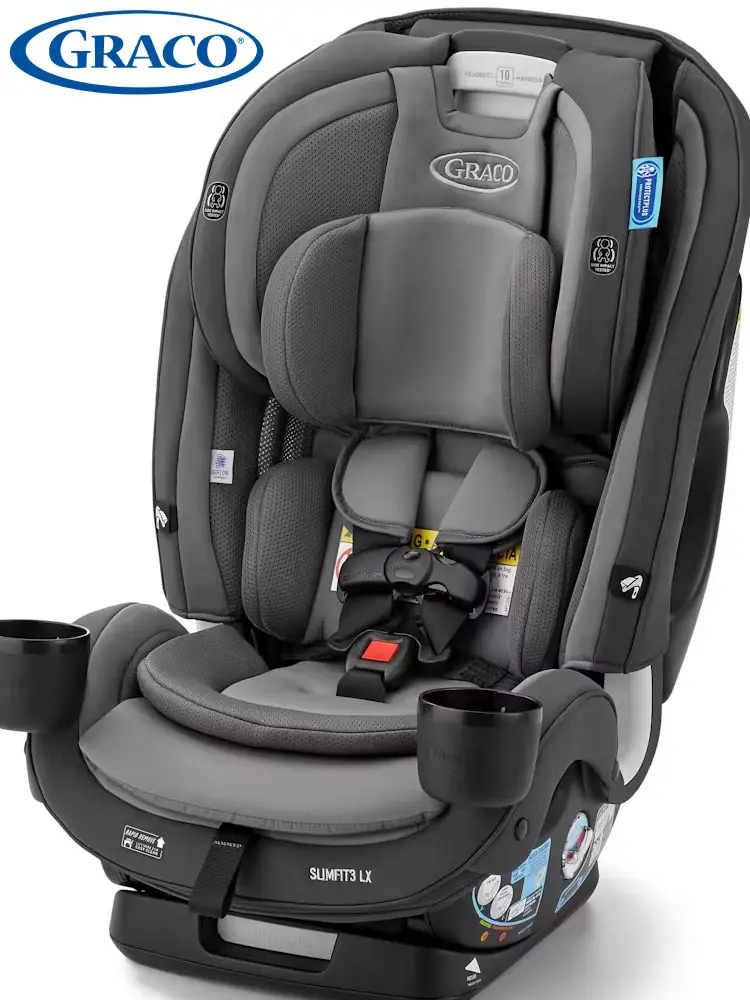
6. Graco SlimFit3 LX Convertible Car Seat (16.7" wide).
The Graco SlimFit3 LX is one of the narrowest convertible car seats available, designed specifically for families trying to fit three across without sacrificing comfort or safety. At only 16.7 inches wide, it’s a full three inches slimmer than the original SlimFit (which is about 20" wide), earning it a well-deserved spot on this list. The SlimFit3 LX is a 3-in-1 seat, accommodating your child from rear-facing (5–40 lb) to forward-facing (22–65 lb) and finally as a high-back booster (40–100 lb). That versatility, combined with Graco’s thoughtful engineering, makes it one of the most space-efficient and practical options for growing families.
In our hands-on testing, the SlimFit3 LX lived up to its name! The narrow shell and cleverly designed rotating cup holders helped us fit three seats across in several midsize SUVs and sedans. Installation was refreshingly simple with either the LATCH system or vehicle seat belt. This was largely thanks to Graco’s SnugLock installation system, which provided built-in tensioning for a secure and confident fit. The seat feels solid yet lightweight (about 19 lb), and the no-rethread harness and ten-position headrest make adjustments quick and intuitive. We also appreciated the plush padding and breathable fabric, which kept our little tester toddler cool and comfortable even on longer rides.
For safety, the SlimFit3 LX includes Graco ProtectPlus Engineering, a system that combines rigorous crash testing for frontal, side, rear, and rollover impacts. The seat’s steel-reinforced frame adds rigidity without unnecessary bulk, and the overall design feels premium for the price point. The only minor drawbacks are that rear-facing installations can reduce front-seat legroom, and the fabric takes some effort to remove for washing. Still, those are small trade-offs for such a slim, versatile, and affordable seat. If you’re struggling to fit three car seats across, the Graco SlimFit3 LX is one of the best solutions on the market. Interested? You can check out the Graco SlimFit3 LX here.
The Top 5 Narrowest Booster Seats of 2025
While some boosters list very low weight and height minimums, we don't recommend transitioning to a belt-positioning booster until your child is at least about 5 years old and mature enough to sit correctly for the entire ride.
By that point, most children are around 45 pounds and 40" tall. If your child is smaller or tends to slouch, lean, or unbuckle, they’ll be much safer remaining in a forward-facing car seat with a 5-point harness.
Always keep your child rear-facing for as long as possible, at least until 2 years of age, and ideally until they reach the rear-facing height or weight limit of their convertible seat.
Note: Some websites still recommend the Immi GO and Mifold Hifold car seats, but they were both discontinued. If you're looking for something similar, check out the WAYB Pico (below)!
Here are the top 5 narrow booster seats we've tested, followed by in-depth reviews:
| ★★★★★★★★★★ (10/10) | At just 17.5" wide, this 2-in-1 harness-to-booster offers outstanding safety, comfort, and build quality. The steel-reinforced frame, deep side-impact protection, and SuperCinch LATCH make it rock-solid in any setup. A top pick for fitting three across while keeping premium features intact. | CHECK PRICES | READ FULL REVIEW | |
| ★★★★★★★★★☆ (9/10) | Only 14.5" wide and under 8 lbs, the Pico folds up for easy carry-on or trunk storage and installs in seconds. FAA-approved for air travel, it’s ideal for families on the go or those needing a narrow, ultra-portable seat for carpools and compact cars. | CHECK PRICES | READ FULL REVIEW | |
| ★★★★★★★★★☆ (9/10) | Measuring 19" wide with dual collapsible cup holders, the KidFit offers excellent versatility, comfort, and safety. Its 10-position headrest and rigid LATCH connectors ensure a snug fit as your child grows. A favorite for its easy adjustments and reliable side-impact protection. | CHECK PRICES | READ FULL REVIEW | |
| ★★★★★★★★☆☆ (8/10) | This 18.5"–21" adjustable-width booster combines plush comfort with rigid LATCH connectors for secure installation. The AirProtect system enhances side-impact protection, and the quick-tilt seatback makes it easier for older kids to buckle themselves independently. | CHECK PRICES | READ FULL REVIEW | |
| ★★★★★★★★☆☆ (8/10) | At just 16.3" wide, this backless booster remains one of the most affordable and space-efficient options on the market. It’s lightweight, easy to move between vehicles, and features retractable cup holders and deluxe padding for everyday comfort. | CHECK PRICES | READ FULL REVIEW |
One of the challenges with narrow harness-equipped boosters is that the LATCH system can usually only be used until your child is about 40-50 pounds, depending on the weight of the seat itself (check the manual). For example, the Chicco MyFit harness booster weighs about 25 pounds.
The LATCH weight limit is 65 pounds (combined weight of child and seat), so that means your child will not be able to use the LATCH once they hit 40 pounds. Keep that in mind when you're reading about all the great LATCH isofix technology the harness boosters use since you likely will only be able to use them for a brief period of time. After that point, you will need to use the vehicle's seat belt to secure the booster, though you can continue using LATCH connectors to hold the seat in place when it's not occupied. For additional options, be sure to check out our list of the best booster car seats.
In-Depth Reviews of the Narrowest Booster Car Seats
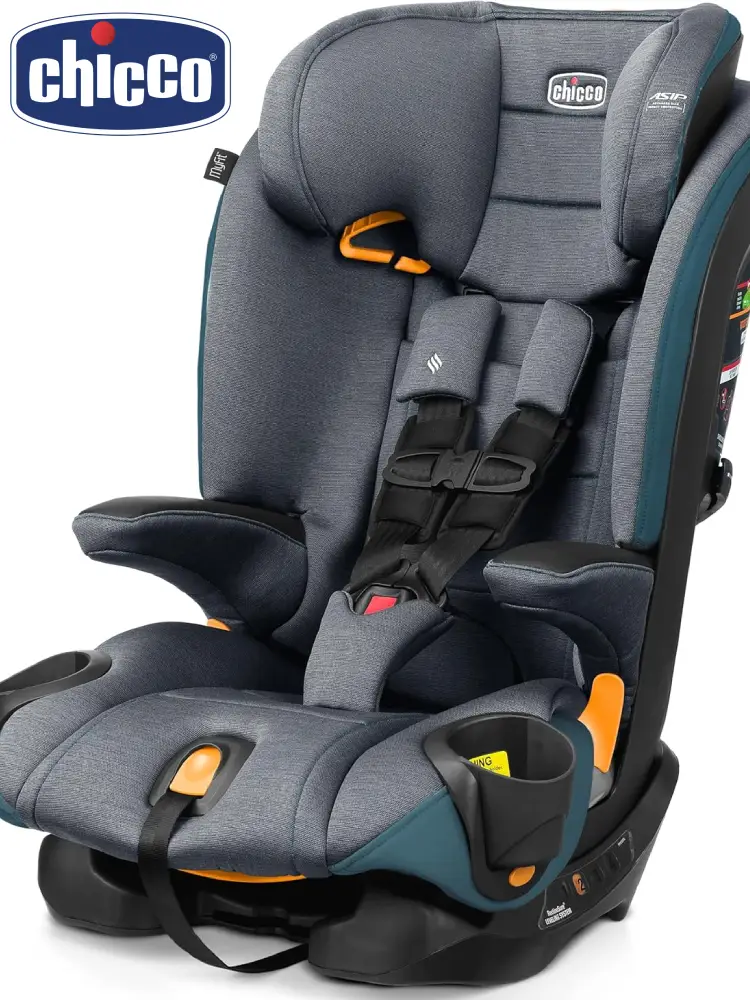
1. Chicco MyFit Harness + Booster Car Seat (17.5" wide)
The Chicco MyFit is a high-quality, forward-facing 2-in-1 harness and belt-positioning booster that offers impressive safety and comfort in a compact form factor. Measuring just 17.5″ wide (with the CupFolders folded in), it’s one of the slimmest combination seats on the market, making it perfect for families trying to fit multiple car seats in a row. Built for longevity, it supports children in harness mode from 25–65 lb (up to ~54″ tall), and in belt-positioning booster mode from 40–100 lb (38–57″ tall).
In our hands-on testing, the MyFit felt sturdy and thoughtfully engineered. Installation was straightforward using either the LATCH system (recommended up to 40 lb) or the vehicle seat belt with a built-in lock-off guide. While the lock-off isn’t the snap-down type found in premium models, it helps achieve a stable fit in most vehicles. In booster mode, you can still use the LATCH connectors to secure the seat when unoccupied, something we appreciate for safety and convenience. The seat’s narrow profile makes it easier to position near a door or alongside other car seats, though belt-based installations can sometimes require a little extra care to keep the seat perfectly upright in tight three-across setups.
Safety and comfort are where the MyFit really shines. It features a steel-reinforced frame, EPS energy-absorbing foam, and deep side-impact protection pods that give you peace of mind on every ride. The nine-position headrest and no-rethread harness make adjustments quick as your child grows, and the four recline positions, padded armrests, and dual CupFolders keep things comfortable and practical. At around 25 lb, it’s not the lightest seat, but the safety features justify the weight. The MyFit earns a “Best Bet” rating from the IIHS and top marks from Consumer Reports, confirming its strong safety and ease-of-use credentials. Interested? You can check out the Chicco MyFit here!
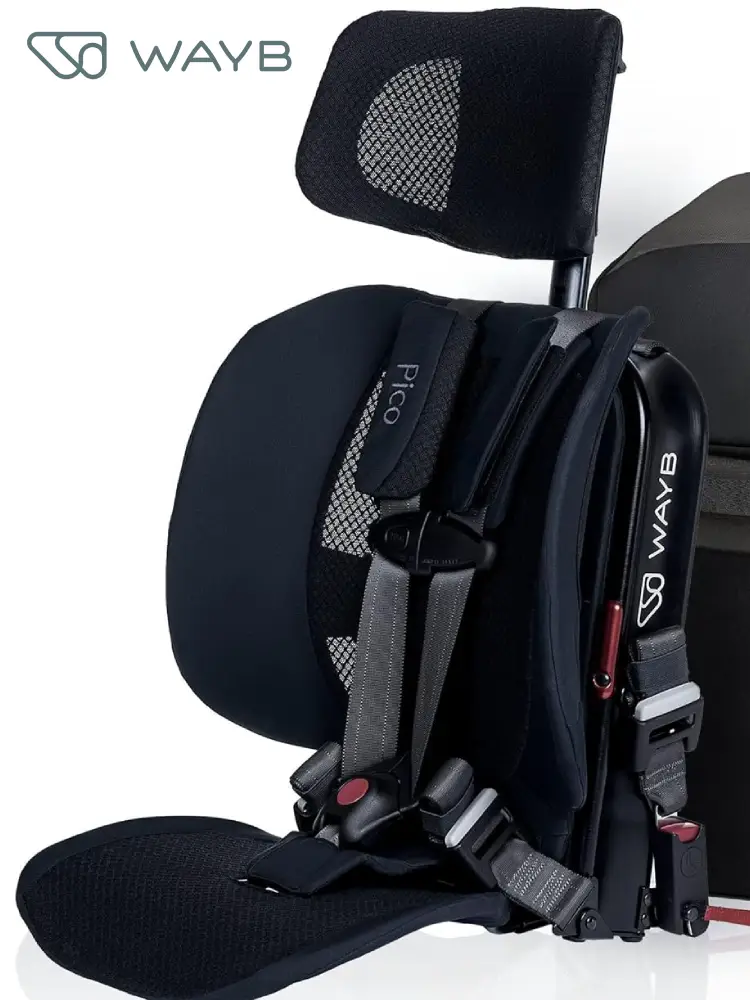
2. WAYB Pico Travel Booster Car Seat (14.5" wide).
The WAYB Pico is a revolutionary forward-facing travel car seat that folds up small enough to fit in an overhead bin while remaining strong, safe, and remarkably narrow. Measuring only about 14.5" wide at the shoulders and weighing just 8 pounds, it’s the slimmest and lightest five-point harness car seat we've ever seen. The Pico can be installed using LATCH, a lap-and-shoulder belt, or even a lap belt only, making it compatible with cars, airplanes, buses, and rideshares. Because the seat itself is so lightweight, parents can use the LATCH system for the entire 22–50 lb range (and up to 45" tall), eliminating the usual mid-transition switch to seat-belt installation that most heavier car seats require.
In our hands-on testing, we loved how easy the Pico was to fold, carry, and install. It fit neatly into the included travel backpack, and we were able to unfold, lock, and secure it in under a minute, making it perfect for airport travel or swapping between vehicles. The Pico’s breathable aerospace-grade aluminum frame and mesh fabric make it ideal for warm climates, keeping kids cooler than most car seats we’ve tested. That said, comfort is a mixed bag: the seat has minimal padding and virtually no headrest or side bolstering, which makes it less suitable for long drives or naps. We also found the harness height and crotch buckle position somewhat limiting: it's great for average 3–5 year olds, but less ideal for smaller or taller children.
Despite these tradeoffs, the Pico’s innovation, build quality, and convenience are undeniable. It’s FAA-approved, meets all U.S. federal safety standards, and represents a huge leap forward in portable car seat design. Perfect for jet-setting families or urban parents who need a lightweight, ultra-compact solution for travel and tight spaces. It’s pricey at around $400, but for frequent travelers, we think it’s worth every penny. Interested? You can check out the WAYB Pico here!
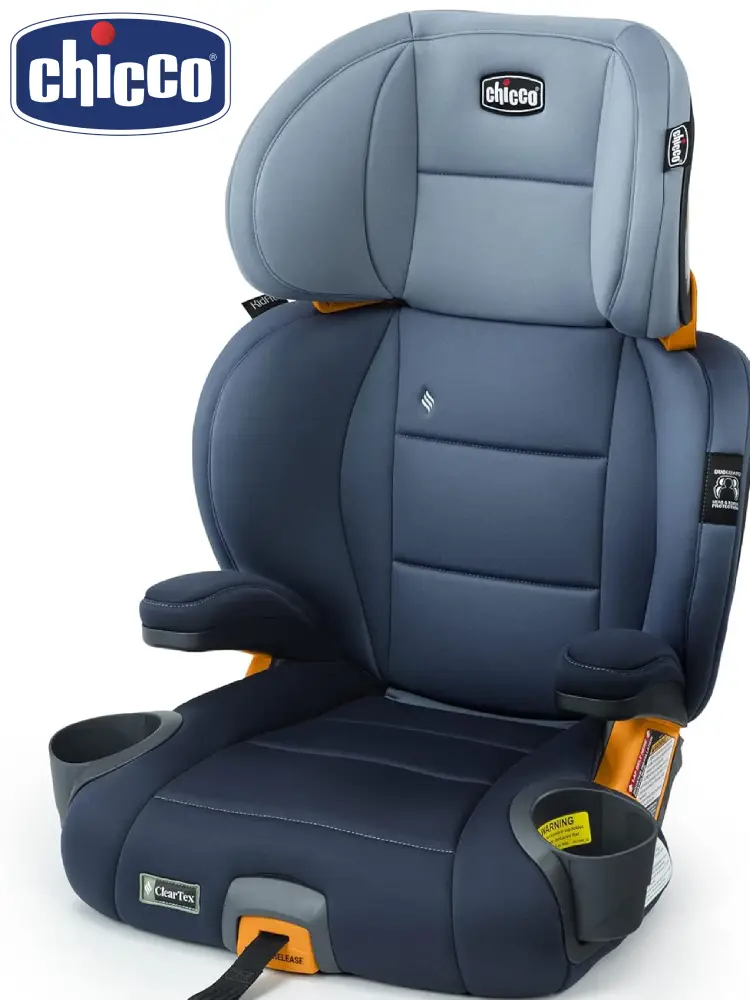
3. Chicco KidFit Booster Car Seat (≈17"–19" wide)
The Chicco KidFit is one of the most popular high-back boosters on the market, and for good reason! It strikes a great balance between safety, comfort, and fit flexibility for families who need to juggle multiple seats across a back row. At its narrowest point, the base measures just under 17" wide (with both cup holders folded in), making it one of the slimmer high-back boosters available. At the shoulders, the seat flares to about 19" across, which is typical for this class and still manageable in most midsize or larger vehicles. In our testing, we found it fits well next to a rear-facing seat or a low-profile convertible like the Clek Fllo or Diono Radian.
Designed for children from 40 to 110 pounds and 38–57" tall, the KidFit functions as a 2-in-1: it starts as a high-back booster and later converts to a backless booster. We appreciate that Chicco recently standardized the minimum weight at 40 pounds, an important safety update that replaces older 30-pound listings still floating around online (disregard them!). Installation is easy thanks to the SuperCinch LATCH system with front pull-tightening, which secures the seat in place even when unoccupied. We also loved the DuoZone side-impact protection design that shields both the head and torso, along with a 10-position headrest and a comfortable two-position recline. At only 10 pounds, it’s lightweight and easy to move between vehicles, and the collapsible cup holders make a real difference when every inch counts.
On the downside, the shoulder belt guide occasionally allows the belt to slip out if it retracts forcefully after unbuckling, so double-check belt positioning before each trip. There’s also no steel frame, but the seat still uses EPS energy-absorbing foam and earns an IIHS “Best Bet” rating for belt fit. Overall, the KidFit delivers outstanding quality for its price and remains one of our favorite narrow high-back boosters for families managing limited backseat space. Interested? You can check out the Chicco KidFit here!
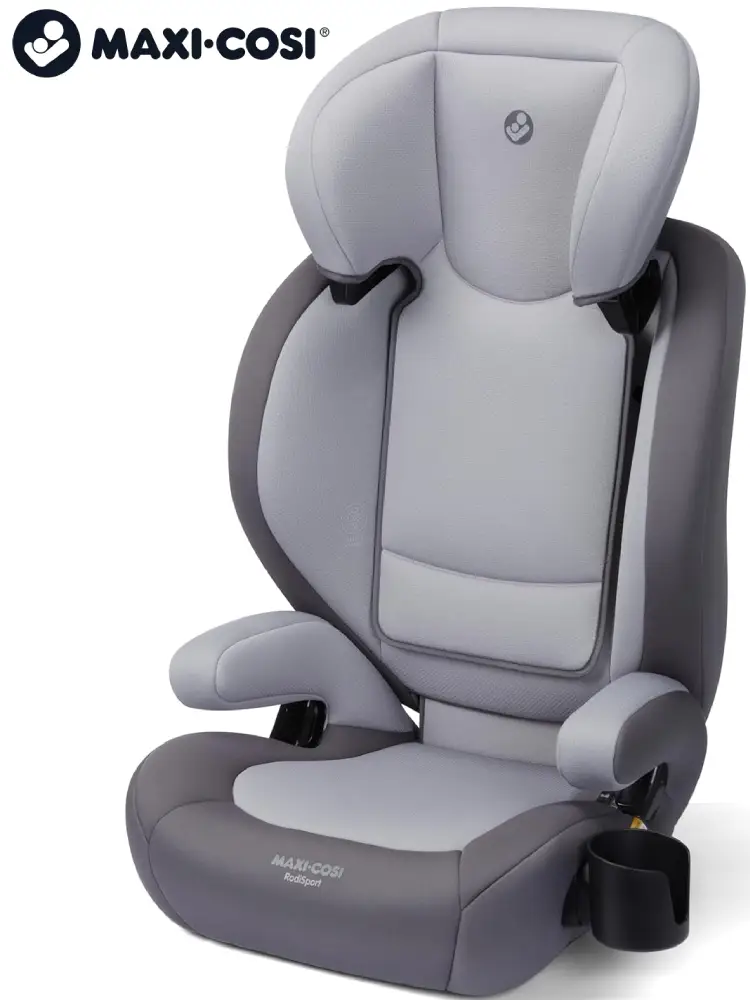
4. Maxi-Cosi RodiSport Booster Car Seat (17.7" wide)
The Maxi-Cosi RodiSport is a stylish, comfort-focused high-back booster that combines European design with practical safety and convenience features. At roughly 17.7" wide (15.7" at the base), it’s not the slimmest booster on our list, but it's still relatively compact for a full-size, high-back model. The RodiSport converts easily to a backless booster, supporting children from 40 to 100 pounds and up to 57" tall. Installation is made simple with rigid LATCH connectors that keep the booster stable when unoccupied, which is a big advantage when loading kids in and out of neighboring seats.
Comfort and adjustability are strong suits for this booster. The 7-position headrest adjusts with one hand, and the seat offers multiple recline settings to better match your vehicle’s seat angle. Plush padding, breathable fabrics, and deep side wings help keep children comfortable on longer rides. For safety, it features AirProtect side-impact technology and energy-absorbing foam throughout the head and torso area. In our hands-on testing, we found the belt guides to be among the most secure and intuitive in this class. They hold the shoulder belt firmly in place and reduce the chance of slippage, which is a common annoyance with other boosters.
While the RodiSport’s upper-torso width means it’s not ideal for very tight three-across configurations, it performs beautifully in midsize or larger vehicles, especially when used alongside narrower convertible seats like the Clek Fllo or Diono Radian, or rear-facing infant car seats. If you want a booster that offers great comfort, easy installation, and a premium feel (without being overly bulky), the RodiSport is an excellent choice. Interested? You can check out the Maxi-Cosi RodiSport here!
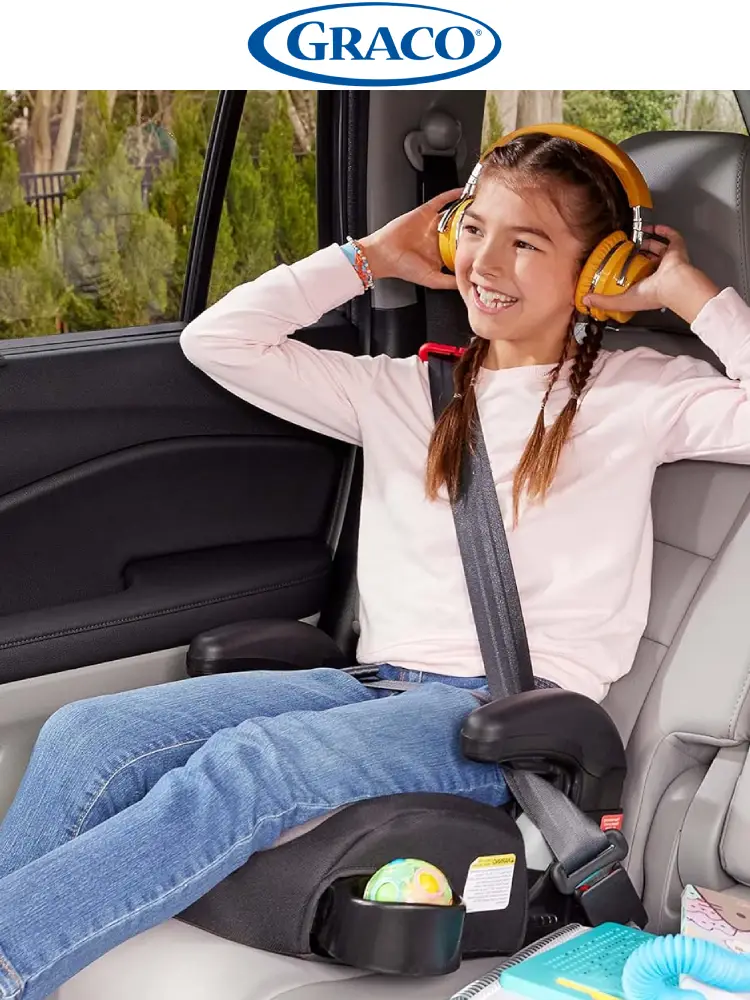
5. Graco TurboBooster 2.0 Backless Booster Car Seat (16.2" wide)
The Graco TurboBooster 2.0 Backless is one of the most popular and practical backless boosters on the market, and for good reason! At roughly 16.2" wide (with the cup holders folded in), it’s among the narrowest backless boosters available, making it a great choice for families trying to squeeze three across. Despite its slim profile, the TurboBooster 2.0 feels solidly built and offers thoughtful features for everyday use, including dual hide-away cup holders, a removable and machine-washable seat pad, and optional armrests that can be detached to save even more space.
Designed for children 40–100 pounds and 43–57" tall, this booster positions the vehicle’s lap and shoulder belts correctly while keeping the child comfortable. It’s Graco ProtectPlus Engineered™ for front, side, rear, and rollover crash protection, and its low weight (around 5 lbs) makes it easy to move between vehicles or bring along for travel. In our hands-on testing, the narrow footprint made installation straightforward (it's very basic, just remembering how to route the seat belt when it's buckled onto the child), even when placing three seats side-by-side, though the lack of LATCH (common for this class) means you’ll need to buckle it in when not in use to prevent sliding around.
It’s not fancy (there's no LATCH, thick padding, thigh support, or premium fabrics), but for under $40, it’s hard to beat its combination of simplicity, safety, and space efficiency. For older kids ready for a backless booster, this is one of the best-value options available today. Interested? You can check out the Graco TurboBooster 2.0 here!
Conclusions
Cars that are probably OK
- Minivans like the Toyota Sienna, Honda Odyssey, Chrysler Pacifica, or Dodge Caravan.
- Full-size cars like the Honda Accord, Toyota Camry, Toyota Avalon, Ford Taurus, or Chevy Impala.
- Mid-size SUVs like the Jeep Grand Cherokee, Honda Pilot, Toyota 4Runner, BMW X5, Acura MDX, Toyota Highlander, Chevy Traverse, Toyota Land Cruiser (250 series), or Ford Explorer.
- Full-sized SUVs like the Chevy Tahoe, Toyota Sequoia, BMW X7, Ford Expedition, Toyota Land Cruiser (200 series), or Nissan Armada.
In those vehicles, three seats in a row should be feasible without much strategic planning.
This is especially true for more recent models, which are increasingly designed with families in mind and often include center LATCH and tether anchors.
Regardless of how large your vehicle is, or whether you have center LATCH connectors, having narrower car seats with LATCH and/or belt tensioners and lock-offs will make the process much easier. The narrower the seat, the better your chance of a secure, stable fit, especially when you’re installing three car seats across.
If you have a third-row seat, you're in even better shape, though you will need to confirm that those seats are equipped with tether anchors. Many modern SUVs and minivans now include third-row tether points, but not all allow for three car seats side-by-side in a third row, so it’s important to check your vehicle’s manual.
In our experience, the most challenging situations occur when you’re trying to fit three of the same car seat styles in a row: for example, three rear-facing infant car seats or three forward-facing convertible car seats. It’s much easier to fit three in a row when you can mix seat types, such as one rear-facing, one forward-facing, and one booster.
Cars that are probably not OK
- Compact sedans like the Honda Civic, Toyota Corolla, Hyundai Elantra, Mazda 3, VW Jetta.
- Crossovers and small SUVs like Toyota Rav4, Honda CR-V, Nissan Rogue, Chevy Equinox, or Mazda CX-50.
We recently tried fitting two booster car seats (the Evenflo Big Kid boosters) into the backseat of a RAV4 alongside a Britax Marathon forward-facing convertible car seat. They only fit when the convertible was in the middle (secured with the seat belt), and the two boosters were on the outside, and it was a very tight fit. Parents had to help during each booster buckle-up (even with a 6- and 8-year-old) because the seats were squeezed so tightly together that reaching between them to buckle was nearly impossible.
The trick was to slide the boosters out toward the doors, buckle them, then slide them back in before closing the door. This created frustrated kids and, as you can imagine, frazzled parents!
Some options
There are a few ways around this situation. The first is to see whether your SUV or crossover offers a third-row seat option. Many midsize and full-size SUVs (like the Highlander, CX-9, Pilot, or Explorer) include a third row, and most full-size SUVs offer three-row configurations from the dealer.
While some smaller SUVs allow aftermarket third-row kits, these are not recommended for safety reasons and may not meet federal crash standards.
A second option is to consider upgrading to a larger vehicle such as a full-size sedan, SUV, or minivan, to comfortably accommodate three car seats across. Many minivans also feature center LATCH anchors as an added bonus.
The final, and often most affordable, option is to be strategic about which car seats you buy and how you arrange them in your existing vehicle. Selecting seats under 17" wide and mixing rear-, forward-, and belt-positioning boosters can make all the difference.
The Secret Fit
The key to success is finding the right combination of the shoulder belt, LATCH, and 5-point harness systems that make life easier for everyone. Ideally, each car seat should use the vehicle’s LATCH anchors to secure it in place, allowing the child to use the integrated harness or booster belt without the seat shifting.
The LATCH helps ensure stability, prevents tilting or sliding, and reduces the need for constant re-adjustment, especially when seats are installed next to doors.
Modern vehicles with side airbags often have minimum clearance requirements between a car seat and the door, making this stability even more critical. Keeping kids in a harness-equipped car seat that’s securely installed using LATCH also avoids the daily struggle of buckling seat belts wedged between tightly packed car seats. Remember, LATCH can only be used up to the combined child + car seat weight limit (typically 65 pounds total, which often equates to a child weight limit between 40–50 pounds). Always verify your vehicle’s and car seat’s manuals for the exact limits.
Bigger Seats, More Safety?
Parents often ask whether a narrow car seat compromises safety. The short answer is no: all car seats sold in the United States must pass rigorous federal safety standards under 49 CFR § 571.213 - Standard No. 213, Child restraint systems. These standards ensure that every car seat, regardless of width, meets minimum criteria for crash protection, labeling, and overall performance.
That said, premium or larger car seats often include additional safety enhancements such as steel-reinforced frames, advanced energy-absorbing foams, load legs, anti-rebound bars, and integrated belt tensioners. These features can provide extra peace of mind, particularly in side-impact or rollover scenarios. However, a properly installed narrow car seat is far safer than a wider seat that fits poorly after installation, or is improperly installed. The bottom line: a secure installation and proper fit are far more important than overall size and safety features.
Even the narrowest car seats on our list meet or exceed the same federal safety standards as bulkier models. For families trying to fit three in a row, the good news is that you can choose slim, lightweight models without compromising your child’s protection, as long as you install them correctly and follow manufacturer and vehicle guidelines.








